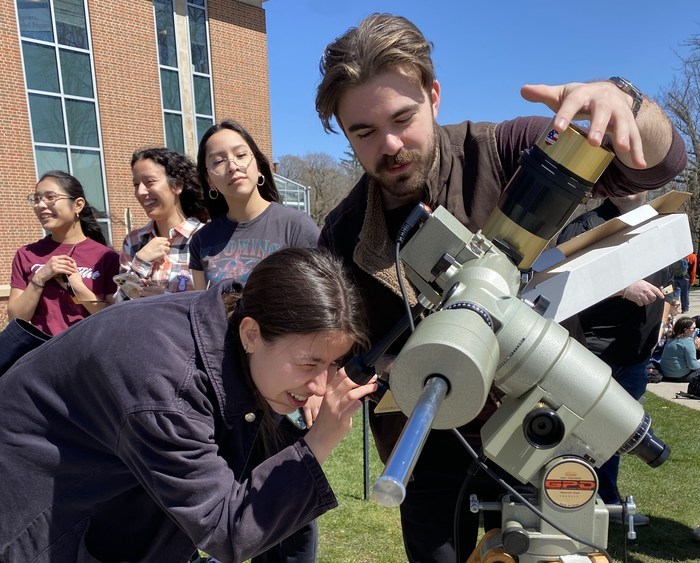Dean Kousiounelos ’25 earns National Science Foundation fellowship

Dean Kousiounelos ’25 has always moved between two worlds—art and science. This polar pairing recently earned him one of the nation’s most competitive awards, the National Science Foundation Graduate Research Fellowship Program (NSF GRFP).
This award recognizes outstanding students pursuing a research-based masters in the STEM field and provides three years of fully paid tuition as well as a stipend. Grant in hand, Kousiounelos is pursuing a PhD in astrophysics at Northwestern University. Lake Forest College prepared him for the academic rigor of the competitive fellowship and graduate studies.
Studying the stars
When Kousiounelos describes his research, his words paint an image: two stars orbiting each other so closely that they shift the fabric of the universe, sending out invisible waves like ripples on water. These “gravitational waves” can be detected by sophisticated instruments such as the Laser Interferometer Space Antenna (LISA), an upcoming space-based observatory scheduled to launch in the next decade.

His fellowship research focuses on predicting which low-mass binary star systems will be detected by LISA. To aid in this study, Kousiounelos will run simulations on Northwestern’s QUEST supercomputer. This work will lay the foundation for major discoveries in the realm of astrophysics, expanding human understanding of how stars live and die in pairs.
Merging of worlds
Kousiounelos always had a love for art and physics, two disciplines many would call opposites. For Kousiounelos, they were never in conflict.
“Creating visual representations of complex phenomena like binary stellar evolution helps me understand the physics deeper while simultaneously making my research accessible to diverse audiences, from research collaborators to the public,” Kousiounelos explained.
Early on, his passion led him to join his high school’s science club where he first encountered Lake Forest College through an alum, Anthony Vaslamis ’12. Vaslamis introduced Kousiounelos to his former physics teacher at Lake Forest College—Professor of Physics Michael Kash ’77.
Kousiounelos’ first meeting with his future advisor was over a Zoom call as college-decision jitters were at their peak. He knew his two passions were far from common, and he was in search of a college that would nurture them in equal portions.
To help him in his decision, Kash connected him with another one of his students, Zoe Darlington ’19, a physics and studio art double major. For her senior thesis, Darlington renovated the college’s Holography Gallery. That was all the proof Kousiounelos needed.
Welcome to the Forest
“Dean is a self-starter,” said Kash, Kousiounelos’ advisor. “He really loves astronomy, and the first thing he did when he got to Lake Forest College was establish an astronomy club.”
Involving the Lake County Astronomical Society, Kousiounelos organized multiple astronomy sightings including the solar eclipse viewing on April 8, 2024. Over one thousand people attended.
His collaboration skills applied inside the classroom as well. Kousiounelos would provide visualizations for everything he studied in his physics classes. In preparation for astronomy, Kousiounelos was able to do an independent study with Kash, learning mathematical methods. He then delved into astronomy at Northwestern University through the university’s Research Experience for Undergraduates (REU).

From seeds to stars
The seed of his research interest was planted in the same garden where it will bear fruit: at Northwestern University's Center for Interdisciplinary Education and Research in Astrophysics (CIERA). Kousiounelos briefly learned about binary stellar evolution during his first REU. There, he had the opportunity to work with a group of exceptional astrophysicists under the guidance of the CIERA director, Professor Vicky Kalogera and CIERA postdoctoral fellow, Dr. Seth Gossage. This set the scene for his growing passion in binary stellar evolution.
Kousiounelos returned the following summer and had the opportunity to run his own large-scale simulations on QUEST. Utilizing the machine’s cluster system, he was able to create the group’s first dataset of detailed low-mass stellar models. This data would later underpin studies of gravitational waves. By the time he wrote his senior thesis, the idea for his fellowship project had already begun to take shape.
Kousiounelos discovered the NSF fellowship through a graduate school prep panel at Northwestern. However, the application process was anything but linear. Writing a professional grant for the first time required persistence, mentorship and community. Kousiounelos relied heavily on the aid of his mentor, Gossage and his advisor, Kash. Mentorship aside, Kousiounelos also credited having a good circle of friends who would listen to him talk about the application endlessly.
“Surrounding myself with people who were passionate about what they were doing made me determined to do well in my field,” he said.
A fellowship across generations
His determination certainly paid off. This summer, history repeated itself as Kousiounelos was awarded the prestigious NSF Fellowship, following in his advisor’s footsteps. Professor of Physics Michael Kash earned the same fellowship in 1977 before pursuing his PhD at the Massachusetts Institute of Technology (MIT). Kash is an atomic and laser phycisist specializing in the field of quantam optics.
Nearly five decades later, Kousiounelos begins his own doctoral journey at Northwestern University this September. He carries with him the roots planted at Lake Forest College—the place where art and science first intertwined. Those roots remain, even as his research now reaches for the stars.
“I can’t stress enough the quality of our physics and art departments,” Kousiounelos said. “They both taught me to deeply question and gave me the tools to attack problems from both qualitative and quantitative directions.”
About the author
Tracy Wamarema '28 is a sophomore at Lake Forest College and a creative communicator with a passion for exploring the human experience in all its forms. Through journalism, film, radio, and poetry, she seeks out the universal threads that connect us while honoring the beauty of our differences.

